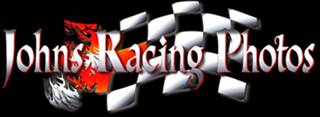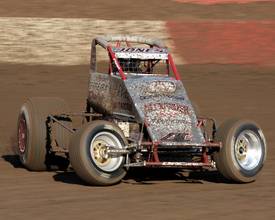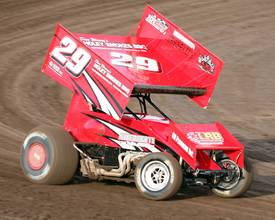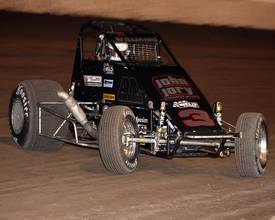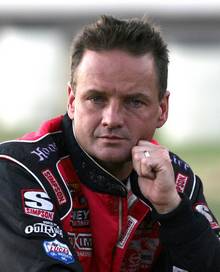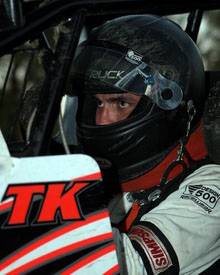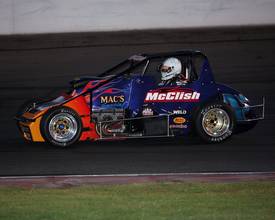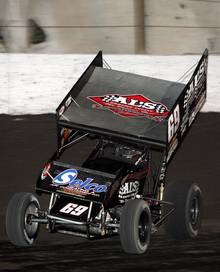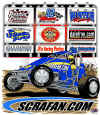


|
Traditional Sprint Car FanSite |
See You At The Races!!! |
|
Interrogation
by Gary "Hammerdown" Costa |
|
|
| Through A Photographers Lens With John Meirhofer |
|
When
I became a self-proclaimed wannabe scribe, John Meirhofer was
always there for me. If he wasn’t lending me his photos for
my interviews, he was lending me his ear, and never asking for
anything in return. I am honored to know this unselfish man.
John has worked his ass off to become one of the top
photographers in the business. What makes this man unique is
also the fact that he is not only a photographer, but he is
actively involved in the sport, trying new things by being
pro-active. He is a die-hard race car junkie. One weekend you
may catch him at Perris, the next weekend he may be at Chico.
I thought it would be neat for us race fans to take a journey
with the man behind John’s Racing Photos… What
were you doing before becoming a photographer? JRP:
When I started I was in the Air Force stationed at Travis AFB.
Currently I am a Medical Equipment Consultant. Obviously,
being a photographer doesn’t pay enough to live on. At least
not in Cali. You’re
a retired Military man. Thank you for serving our Country. How
long were you in the service?
JRP:
I was in for 24.5 years. It was an excellent experience and
has put me where I am now. I had a charmed career in that I
never had to live overseas or get deployed to parts unknown
like so many of my friends did. Every day, every person
reading this now should take a moment and think about those
making sure our freedoms remain intact.
-Tony Jones gets aggressive at Perris No
doubt John. How did you get into motorsports photography? JRP:
My Dad gave me a Sears 35mm camera and a couple of lens. I
played with it for a couple of years at NASCAR races and got a
few shots published in Racing Wheels and Speed Sport News. I
never took a photography course or Photoshop course. I just
sort of learned as I went. Things were different then. You
shot a roll of photos with each photo at a different setting
and made notes. Sometimes you were dead on, sometimes not. You
kept the good notes and tossed the rest. With the exception of
auto focus I still use all manual settings. Of course now you
can get a relatively good starter set up for less than $1000
and be reasonably proficient using the auto settings right out
of the box. Just
like a driver’s competitive passion to win, you’ve
progressed into one of the top photographers in the Open Wheel
world. Your work has been featured in the racing magazines,
racing newspapers, websites, etc. My question is; are you
competitive against other photographers?
JRP:
Yes and no. I think you have to be at least a little
competitive at times to get the shot you want. I do try to
help others when I can. Like I said, I did not take any
courses to get where I am. Other photographers helped me and I
would like to think I have helped others.
But in the end we are all trying to make a business out
of photography. Which
type of race car is harder to shoot; winged or non-winged
Sprint cars? JRP:
That really depends on the angle you are trying to get.
Panning is the key to getting a good clear shot.
Getting the angles right would be the hard part.
If you cannot see the driver, or at least part of them,
the photo to me is a bit boring.
That makes the winged cars a bit harder in that
respect. On the
other hand getting a decent shot of a non-wing car is hard
because there is no wing to fill in the picture.
That makes it harder to get a decent shot with out a
lot of unwanted stuff showing up in the background.
-Willie Croft pounds the Chico clay How
about track size. Do you prefer smaller tracks like a
Placerville or larger tracks like Manzanita? JRP:
I have been saying this for a couple of years now and many
disagree with me. Anything
larger than a 3/8th for dirt sprint cars or midgets
is going to be a boring freight train race. All of the cars
are so evenly matched, and the drivers all of such high
caliber these days, it is virtually impossible to advance on a
big track. When everyone qualifies within a second of each
other, by the time the main comes around those 24 cars are
within .5 second of each other lap wise. It doesn’t take a
rocket scientist to figure out that it will take about 30 or
so laps for the fastest car to catch the slowest car on a ½
mile track. You could do a total inversion but you would just
wind up with guys sandbagging to start in the front. What
are you looking for at each track? JRP:
Something different to shoot. Not much more than that really.
I am just happy to be at the track watching a race. Every time
I go to a track I try to think about what I am taking the
photos for. Then I try to come up with an angle or idea that
will make it different or better than the rest. Sometimes it
works and sometimes it doesn’t. I
can speak from experience on your generosity. I see your
pictures allover the internet on drivers’ websites, etc.
Some photographers are hard cases about sharing photos, but
not you, why? JRP:
The same folks that are the recipients of my “generosity”
as you say are the one’s that make John’s Racing Photos
possible. They
buy the photos all year long and year-after-year.
The least I can do is help them out with photos for
their websites. As time has gone on it has become harder and
harder to accommodate everyone that needs photos for their
site. That is why I started “The Big Picture”. It is a pay
site (mostly to help offset the cost) but it is a nominal fee
and allows anyone that subscribes to get the photos they need.
-Rip Williams shows form at Manzanita Tell
us more about “The Big Picture” http://www.johnsracingphotos.com/
what’s it all about?
JRP:
“The Big Picture” is a pay site that gives subscribers
access to nearly 30,000 photos from John’s Racing Photos.
They date back to 2003 currently. Soon I will be adding photos
from prior to that. All
photos are in 800x640 and at 150dpi. This means you can use
them as wall paper or a screen saver on your computer, if
you’re a team use them for your website or hero cards (with
credit given of course), and in most cases even print them up
to 5x7. By the end of 2008 there will be nearly 50,000 photos
from not only sprints and midgets but NASCAR, NHRA, CART and
IRL. If
you could pick one track that you could shoot every week,
which one would that be, and why?
JRP:
I don’t think I could shoot at the same track week after
week. Eventually I would get bored and not go. You can only
shoot the same cars in just so many angles.
What
track are you just itching to shoot?
JRP:
All the tracks I have not been to. I really want to shoot at
Ventura though, before I leave California. There and Quincy
are the only dirt tracks in CA that I have not been to. I am
really looking forward to my move back to the Midwest. I went
to Beaver Dam this year for WoO sprints. I had not been there
since the late 70s. It has changed a bit. I cannot wait to see
how some of the other tracks look now.
-Craig Dollansky in deep thought I’ve
seen your flip sequences. Is it a matter of just being at the
wrong place (for the driver) and the right place for you?
JRP:
Pretty much. I am
generally in turn two once the heat races start and stay
there. Sometimes there is a lot that happens and sometimes no
so much. You just
have to pay attention and watch. Sometimes I notice drivers
trying to make something happen that I just know in the back
of my mind won’t work. Sure enough a couple laps latter they
give me one of those 10 frame flip sequences. I think the
photographers that take the best shots understand the cars,
the tracks and the drivers. If you don’t take the time to
learn what you are shooting you have no way of knowing what
makes a good shot. Once you do that you can tell what a car is
doing or not doing and what the driver is getting ready to do
to make something happen for them. Now,
during the flip sequence, you’re sometimes vulnerable to the
race cars. Do you have a technique that you use to avoid
injury, besides running! JRP:
Running is pretty much it. (laughs). I always make a mental
note of where the tires and light poles are. A tire won’t
stop a car, but will hopefully slow it down enough to get
away. When the racing is tight I also shoot with both eyes
open. Speaking
of running, I’m sure you’ve ran a time or two. With that,
please share some stories with us...
JRP:
One time at Chico I was standing in front of the infield tire
and a car spun into the infield right at the tire. The safety
crew was standing on the tire.
There was a ton of dust and after the car stopped one
of them started calling my name because he thought I had been
hit! I had moved out of the way and actually wound up with a
photo of them bailing off the tire. Also, this year at Manzy
for The Copper, during hot laps for the midgets, I felt
something skim across my lens and glanced to the right just in
time to see something blue bounce off into the dirt. After
that session I went and checked and found a bleeder. Who
always seems to spit fire in your lens when they hit the race
track? JRP:
If by spit fire you mean shows sheer determination and will I
would say three people come to mind, all from California. The
look in there eyes even during qualifying is one that is
unforgettable. Those three are Damion Gardner, Tim Kaeding and
Jonathan Allard.
-TK readies for war Great
choices! Now in what ways do you shoot differently, let’s
say from the heat races to the main event?
JRP:
During hot laps and qualifying it is all about getting the
single car photo that can be used for media promotion. A crisp
clear photo that shows all of the sponsors. During race action
it is just that, trying to show racing. What
type of surface do you really like to shoot at? Tacky or
slick, and what changes do you have to make as a photographer
throughout the night? JRP:
I personally like the tacky tracks. I like to see the left
front pulling up off the turns. I do like the occasional slick
track just to see the versatility of some drivers. When
the main event does go green, what part of the pack do you
follow barreling into the turn? JRP:
I usually follow the third row back. Somehow someone will
manage to take even the narrowest of tracks three wide and I
do like to capture that when it happens.
Who’s
your favorite photographer(s) and why?
JRP:
I would have to pick Michael Hill. Not because of his race
photos but his landscapes. He puts a lot of thought into his
photos and the artistic side of it really shows through,
especially in his landscapes.
-Brian McClish at Madera You’re
not only a photographer; you’re also involved in making
“hero-cards”, websites and some other nice things as
well... JRP:
Although I do not do as much as I would like to I do, I like
to “design” stuff with Photoshop and my photos when I can.
I do make handouts and custom photos.
I can also design websites from a one page design to
multiple pages. I wish I had time to do more of it. SprintCar
PR is going to be the avenue for me to do that. Eventually I
would like to be able to offer a team an entire media package.
One that would include everything from the hero card to
the graphics on the hauler, the website, t-shirts, team
shirts, media packets for sponsors and other general
merchandise. Tell
us more about SprintCar PR http://www.sprintcarpr.com/
share with us what the website is about….
JRP:
SprintCar PR was started as a means of providing everything
Sprint Car in one location. We are working on getting writers
from across the country to put out media content for the
drivers they represent. We also provide a place for
photographers to sell there sprint car photos, drivers without
websites to sell their merchandise, or get a website. We will
be adding T-shirt designers (most notably Randy Frank) and
print companies where you can get your T-shirts designed and
printed. Graphic designers that can do vinyl work for your
car/hauler and what ever other content we can fit in as it
pertains to Sprint Cars. By the end of next year I am hoping
to have a 10-20 minute weekly web cast as well the will
showcase major races across the country with both video and
commentary. And of course, it is also a place for
manufacturers to advertise their product where it will reach
their target audience. SprintCar
PR put up some money for “The best appearing car” at this
years Gold Cup. The immaculate NMI Sprint car driven by masher
Greg DeCaires took this years honors. Is this a long term deal that you’re trying to do, if so why? JRP:
I hope it turns into a long term deal. I don’t really intend
to do it long term myself, but I do hope that it becomes a
regular part of the Gold Cup. I am tossing around some ideas
for next year with a few others that include having it as a
“Best Painted Car” award with money paying out to the
owner and painter. Most of it will depend on what kind of
sponsor we can dig up to support it. It costs a considerable
amount of money and time to hand paint a car so a significant
sponsor is going to be needed. (Hint! Hint!)
-GSC Champ BK at Calistoga You’re
an important part of the racing community, so I need to ask;
what’s next for John’s Racing Photos?
JRP:
The next thing for me is to move to the Midwest. Sometime in
2008, I will be moving to Eastern Iowa. Hopefully I will be
able to pursue John’s Racing Photos and SprintCar PR full
time by the end of 2008. I
must thank you my friend for all that you do for us, and
allowing me to “Interrogate” you. We’ll catch you down
the road… JRP:
Your welcome my friend! Be
sure to check out John’s photos here
http://www.johnsracingphotos.com/ |
